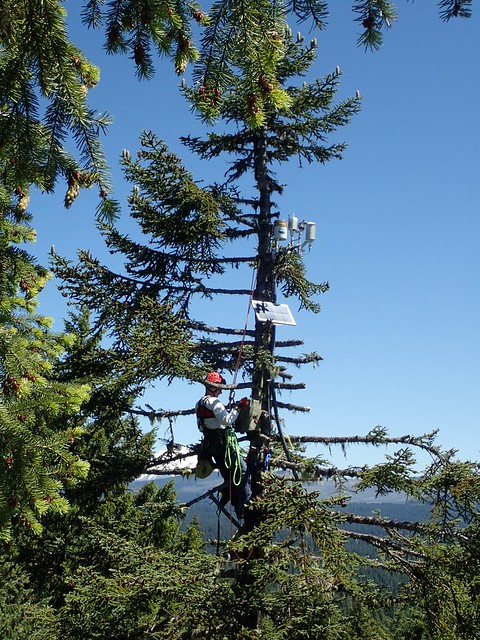Type of Event: Field study
Topic: Canopy microclimate monitor
Organization: EPA
Location: Soap grass, Tall creek, Woods creek (NSFS)
Host: Peter Beedlow, Ron Waschmann and Sky Lan
International Fellows: Rebecca Hsu (Taiwan)
 |
EPA climatologist Ron Waschmann
working at a weather station on an old-growth noble fir tree |
During my fellowship at WFI, I was invited to do field work with EPA, installing weather stations, and measuring canopy allometry on old-growth Douglas fir trees.
Following are the lessons learned during the past few months.
How to rig a tree
 |
Peter using a crossbow to
shoot a fish line to the canopy
|
To access the canopy of a 'wild tree' (a tree that has never been climbed before) the first step is to rig it. This is usually the most difficult part of canopy research. First, old-growth forest are always very dense, making it hard to see through the canopy and very difficult to shoot the rope to the canopy. EPA researchers use a crossbow (150 lbs or bigger) to shoot a fish line into the desired branch, connect it to a thicker line, and then to a climbing rope.
 |
My husband Brian Chiu helped to
get leaf samples from old-growth
Douglas during his visit
|
How to climb a 'wild tree' by using a single rope system
 |
Using rope wrench & prusik hitch to
climb tree, a new skill I learned
|
I learned a convenient climbing technique from a professional arborist in Portland Oregon, Brian French. And I was able to practice the newly learned climbing technique doing field work with EPA. The single rope system is lighter weight than other systems and it will be of great benefit on my long hiking expedition in Taiwan.
The first time I used this technique for a long descending the rope was burned black! I went back to Brian and he told me how to improve the 'prusik hitch'. Using borrowed gear can be tricky but once I learned to work with it field work became much more enjoyable.
The first time I used this technique for a long descending the rope was burned black! I went back to Brian and he told me how to improve the 'prusik hitch'. Using borrowed gear can be tricky but once I learned to work with it field work became much more enjoyable.
For me the canopy allometry measurements probably were the hardest part of that field work. Thus, it is the only (and cheapest) way to understand the canopy structure of an ancient tree in the old-growth forest. I hope Lidar technology improves in the future to eliminate this step. But until then we will have to hang on the canopy for hours to days to measure a tree girth every 6 feet, and branch characteristics (eg. angle, direction, width, leaf ration etc). Imagine a 200-feet tree with more than 100 branches! Then science stops being romantic!
How to install a weather station
My main research interest is in monitoring canopy microclimate. The EPA climatogist Ron was so kind to demonstrate how he installs a weather station and shared his tricks on modifying weather sensors and other equipment's. EPA has been collecting high quality climate as well as tree data for more than 20 years! As a field ecologist, I know how devoted and determined those guys are. I am so glad I had the opportunity to meet these serious scientists in the Oregon!
 |
| Ron demonstrating how to install a simple and short-term weather station |
International Fellow Reflection
- Microclimate and canopy structure are crucial for knowing the whole picture of healthy forests
- Experience and practice are crucial for improving climbing technique
- Accuracy and luck are crucial for rigging a tree
- Patience and fitness are crucial for measuring canopy allometry
- Calibration and custom modification are crucial for monitoring long-term climate change

No comments:
Post a Comment